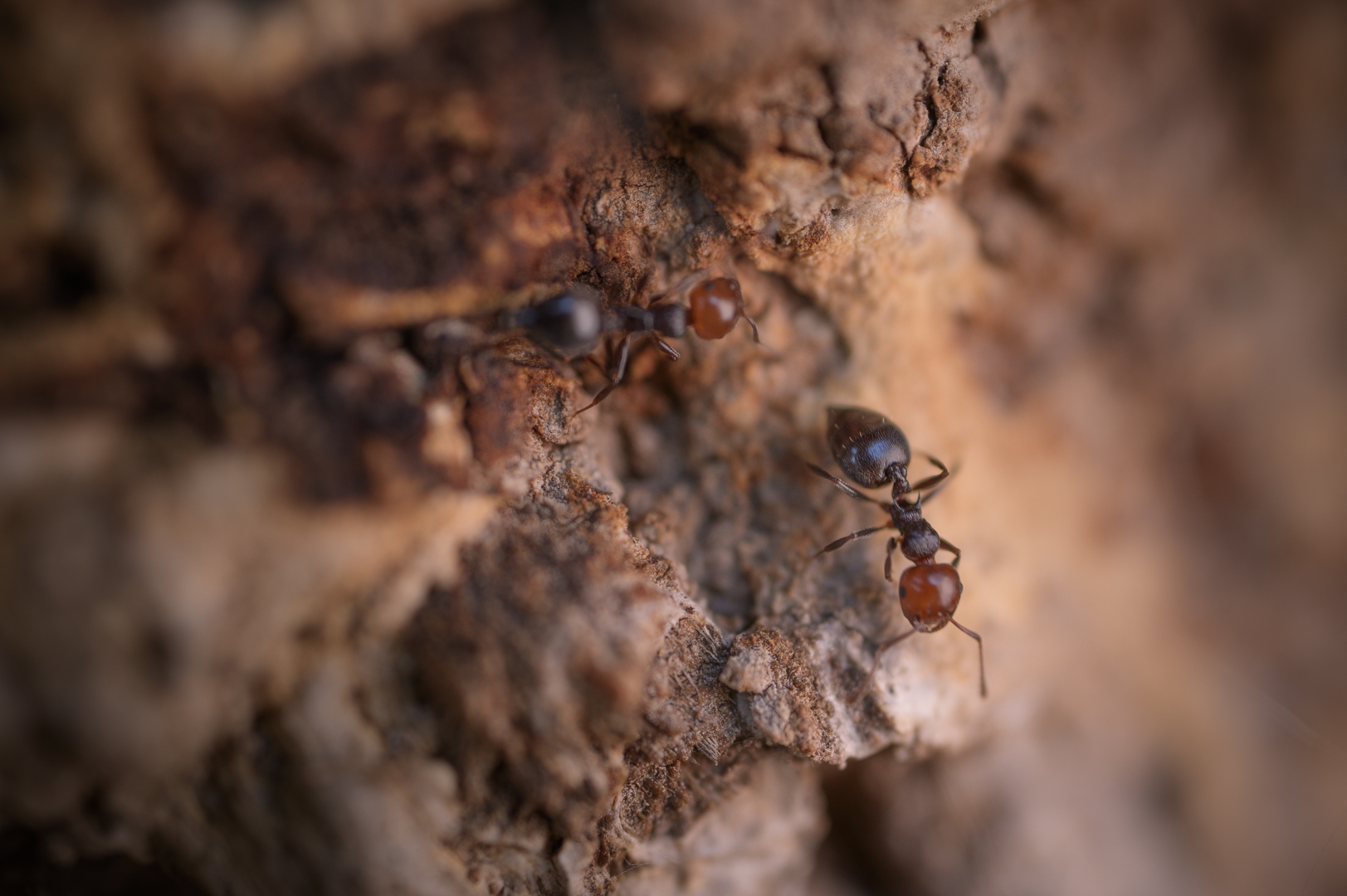The Argentine ant: the invader among the Doñana’s cork oaks

The Argentine ant (Linepithema humile) competes with the Romans: its supercolony stretches from Doñana to Italy. / Alejandro Muñoz
In the 1970s, the old Doñana Palace underwent extensive renovations. It is believed that during this time, the Argentine ant (Linepithema humile) arrived in the building —the headquarters of the Doñana Biological Reserve— hidden in the soil and materials used for the construction work. Since its arrival, the ant’s relentless expansion has caused damage to birds and amphibians. Researchers and technicians at the Doñana Biological Station (EBD-CSIC) are also investigating its impacts on trees, nutrient cycles and essential processes such as seed dispersal and pollination.
Originally from South America, its mere three millimetres hide an unstoppable invader. Its tiny size enables it to hitch rides in various goods, including wood, plants, and containers. A single queen is enough for this ant to establish itself in a new environment.
‘It is the true Trojan horse of insects. The Argentine ant ranks among the 100 most harmful invasive species in the world according to the Global Invasive Species Database 2024 and is listed in the Spanish Catalogue of Invasive Alien Species,’ warns José Manuel Vidal-Cordero, an entomologist in the Environmental Monitoring Area of the Singular Technical Scientific Infrastructure - Doñana Biological Reserve (ICTS Doñana), managed by the Doñana Biological Station.
A textbook invader
Linepithema humile has several advantages over native ant species. Firstly, it is polygynous, meaning it has multiple queens that lay eggs simultaneously. Secondly, it is polydomous, with colonies capable of spreading across multiple nests. Additionally, this invasive species is able to monopolise environmental resources and displace native species.
One of its most remarkable abilities is the formation of supercolonies. ‘Imagine taking an Argentinean ant from Doñana and taking it to the Italian coast. If you release it there, in an colony of the same species, they wouldn’t fight. We are talking about a colony spanning thousands of kilometres —a supercolony,’ explains Vidal-Cordero

Native ants, such as Crematogaster scutellaris, abandon cork oaks invaded by the Argentine ant. / Alejandro Muñoz
In Europe, three super colonies of Argentine ants have already been identified. This phenomenon means that the different colonies do not attack each other and even cooperate. Studies suggest that this behaviour is due to the reduced genetic diversity among individuals, all descended from the first ones that arrived on the Iberian Peninsula by boat years ago.
‘All these characteristics make it a textbook example of an invasive alien species,’ says entomologist José Manuel Vidal-Cordero.
The small art of war
There are more than 40 species of ants in Doñana. Since the incursion of this invasive species into the emblematic Andalusian protected area, researchers at the Doñana Biological Station (EBD-CSIC) have been studying its expansion tactics.
While Linepithema humile struggles with extreme temperatures, its advance into the biological reserve – located within the national park - is limited to human constructions and other natural refuges, such as large cork oaks. These century-old trees serve as crucial climate refuges during the summer. Since 1992, researchers have tracked the spread of the Argentinean ant has been documented.
But how can this tiny stranger travel long distances without the ability to fly? In fact, a 2019 study suggested that the ant flies to invade new trees as a stowaway for carrion consumed by raptors. Once in the nest of specimens such as the black kite, the queen and workers continue their aggressive expansion, killing and displacing native ant soecues they find in the tree, such as Crematogaster scutellaris.
Small outsiders and big impacts
This unstoppable expansion has numerous negative consequences, many stemming from its ability to eliminate other ant species. ‘When this invasive species becomes the only one left, the roles previously played by native ants —such as seed dispersal or the pollination of certain flowers— are lost,’ explains Elena Angulo, a scientist at the EBD-CSIC and an expert on the Argentine ant.
For cork oaks, aphids flourish under the control of the Argentinean ant, negatively affecting the health of these iconic trees. The Argentine ant is a livestock ant, protecting the aphids to obtain their honeydew, as if it were milk. This invasive species also impacts on the breeding of birds nesting in invaded trees. In a study conducted by Elena Angulo's team, chicks in trees inhabited by the Argentinean ant were found to be smaller size and poorer nutritional condition.

The Doñana Biological Station (EBD-CSIC) has been conducting periodic monitoring of the Argentine ant in the reserve since 1992. / Alejandro Muñoz
However, the most striking impact of this species is on amphibians. A team from the EBD-CSIC revealed that the Argentine ant attacks young toads as they emerge from ponds after metamorphosing from tadpoles.
‘We found that the ant has a poison, iridomirmecin, which acts on cold-blooded species such as, paralyzing them,’ explains Elena Angulo, one of the study’s authors.
Remarkably, just 20 ants are enough to paralyze a juvenile natterjack toad (Epidalea calamita), despite their much smaller size. The venom burns their skin and can even prove fatal.
Stopping the invasion
The Argentine ant is just one example of the tremendous negative impacts invasive alien species have on ecosystems—sometimes due to carelessness or mere coincidence. These effects are not only ecological but also economic. In 2022, the CSIC led an international study that estimated the global economic impact of 12 invasive ant species at €46 billion.
In the Doñana Biological Reserve, monitoring protocols record the small but significant advances of this invader each year. After the severe droughts of recent years, its population appears to be weakening.
‘Perhaps now is the right time to consider its eradication from the park,’ suggests Elena Angulo, a researcher at the Doñana Biological Station.
Alejandro Muñoz / Content developed as part of the CSIC-BBVA Foundation Science Communication Program, 2023 Call for Proposals.